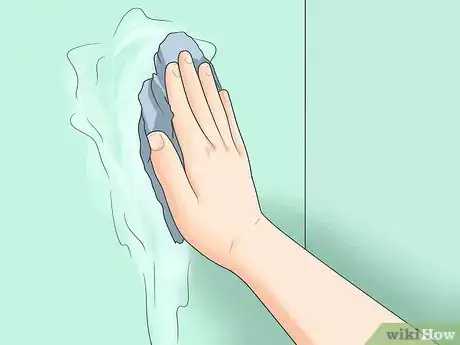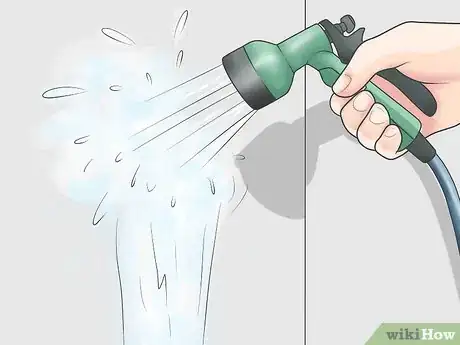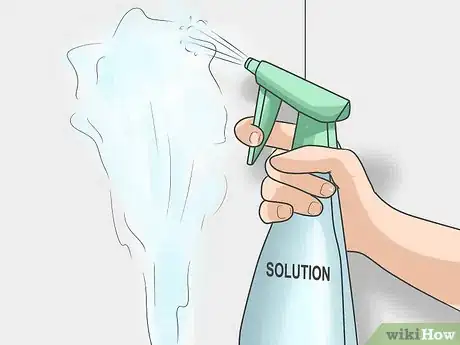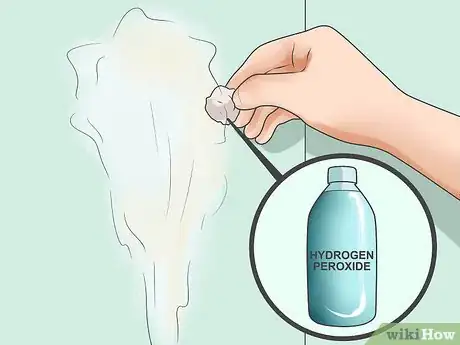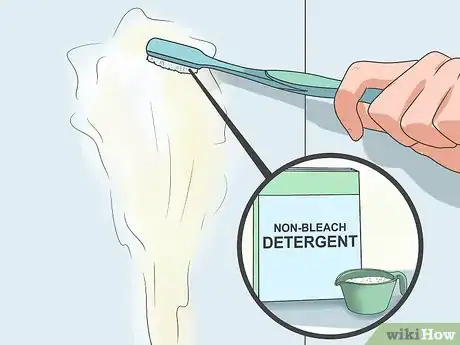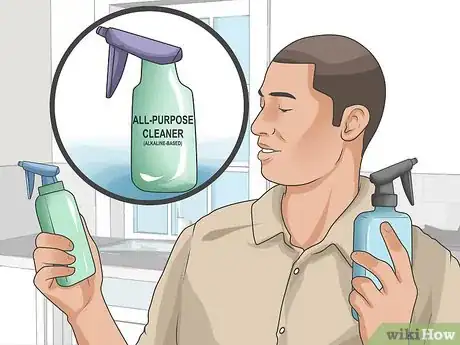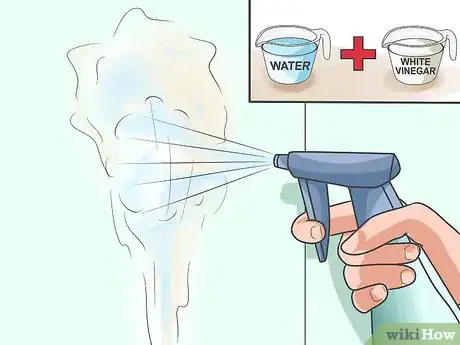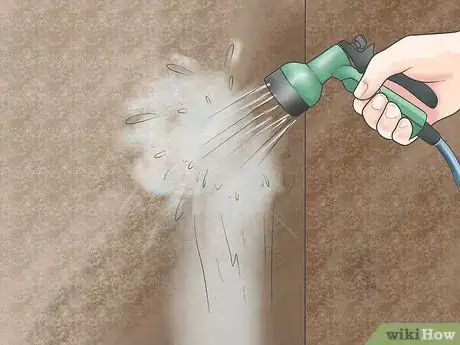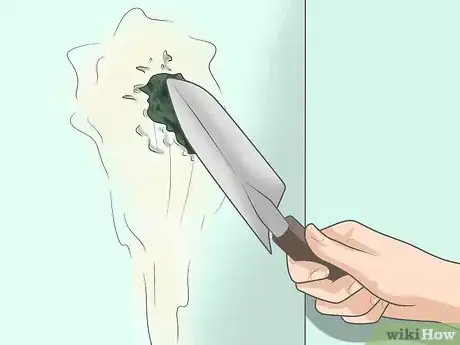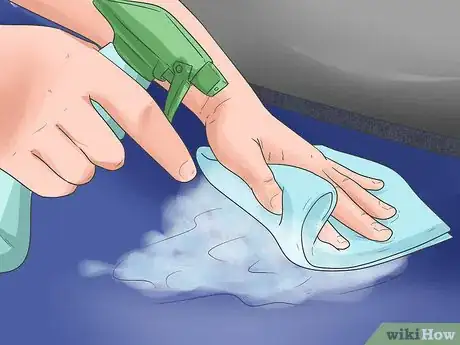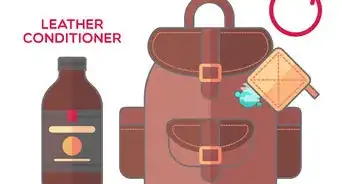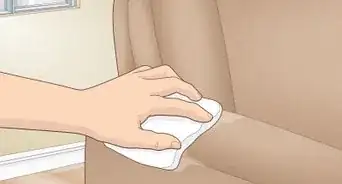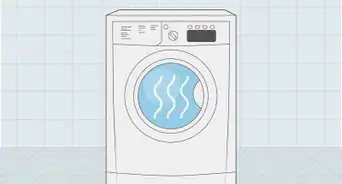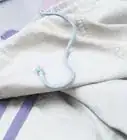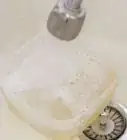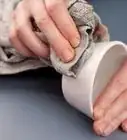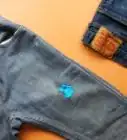This article was co-authored by wikiHow Staff. Our trained team of editors and researchers validate articles for accuracy and comprehensiveness. wikiHow's Content Management Team carefully monitors the work from our editorial staff to ensure that each article is backed by trusted research and meets our high quality standards.
This article has been viewed 246,018 times.
Learn more...
Egging a house has been a longtime prank. As anyone who has been the victim of egging knows, eggs are difficult to remove from a home's exterior, especially when they dry. However, with some elbow grease and especially if you act fast, you should be able to get the egg off your house.
Steps
Getting Rid of the Excess Egg
-
1Wipe away any excess egg easily removed. Act fast. The quicker you remove the egg from the side of your house, the better off you will be. When egg dries, the stains become more stubborn, although still removable.
- In particular, you want to make sure that you get rid of any pieces of shell fastened to the house. Try to get rid of any looser pieces of the egg that you can easily remove.
- Due to their high moisture content, eggs remove somewhat easily when the egging is fresh. Prepare cleaning supplies as soon as you notice that your house has been egged.
- You could also use a dull knife to scrape off excess egg stains. Or you could use a cloth or soft-bristled brush. Wipe away any egg that you can easily see. Be aware that some residue will likely remain.
-
2Spray water toward the egg stain. Take a hose, power sprayer, or pressure washer, and direct a stream of water at the remaining egg stain.
- The water pressure in the hose will help remove some of lingering egg residue. You don’t want to scratch the house while removing the egg, which is why it’s important to hose off or remove any loose shells.
- Wash the egg downward. Wet the area beneath the egg before you do so, so that it doesn’t stick as it is washed downward. Avoid using hot water on the egg at any time because it could actually cook the egg enough that it will become harder to remove from the side of your house.
- Put the hose on low pressure, and use warm water if possible. Try not to use a high-pressure hose, because this can move the egg to other areas of the house. You can buy or rent pressure washers at local hardware stores.
Advertisement -
3Test an area first. If the remainder of the egg stain doesn’t entirely come off with the water spraying, you’re going to need to apply a cleaning solution to your house siding.
- By testing a small area of the stain first, you can see if the cleaning solution is removing any of the paint.
- There are times that you will need to repaint the area that was egged. However, you may be able to remove the egg without causing that issue.
- Most cleaning procedures work for aluminum or vinyl siding, although more unique sidings like stucco can require a more intense cleaning process.[1]
Using Cleaning Solution to Remove Egg
-
1Soak the egg stain. Especially if the egg stain is old, it might be congealed and harder to remove. Soaking the egg stain makes it easier to get it off with chemicals.
- If you have light siding, you could dab hydrogen peroxide on the stain first to weaken it. If your paint is a darker color, don’t use this, though, because it is a bleaching agent.
- With darker stains, you should try non-bleach laundry detergent and water to loosen up the stain before you try to completely remove it.[2]
- You could also soak your rag in the cleaning agent you choose, and blot the stain with it, in order to loosen it. Leave whatever chemical you apply to the stain on it for a few minutes before moving to the next step.
-
2Mix laundry detergent in water. This is one of the most common ways to remove egg stains from a house.
- Take 1 cup of non-bleach laundry detergent, and put it in a bucket of warm water. If the egg has already dried, the stain will be more stubborn and probably require detergent. You could also try using dish soap or even shampoo. You want to choose a gentle cleaner that doesn’t have bleach in it.
- Take a scrubbing brush with bristles, and dip it into the soapy water. Scrub the egg gently with the warm soapy water.
- Rinse the area. Once you’ve scrubbed the egg-covered area with the soap-and-water-mixture, rinse it off with the hose or pressure washer. Repeat the process if it’s needed.
-
3Try an all-purpose household cleaner. Instead of detergent and water, you could use an all-purpose household cleaner, but make sure to choose one that is alkaline-based.[3]
- Alkaline-based cleaners will get rid of the egg stains more effectively by dissolving the fats in them. Formula 409, Zep, and Simple Green are examples of household cleaners that are alkaline based.
- As with the detergent, put the cleaner in warm water, and gentle scrub the stain. Then, rinse the area to get rid of the remaining cleaner and egg.
- When using alkaline cleaners, take care to wear gloves and eye protection, and read the label to avoid any irritation to your skin. Use a cleaner recommended for removing organic, high protein matter like blood, grass or food.[4]
-
4Use white vinegar. To give the cleaning solution more oomph, try adding some white vinegar into it. White vinegar is an effective, natural cleaning solution for many surfaces.[5]
- Mix one cup of white vinegar into one cup of warm water. Put the mixture into a spray bottle that you’ve cleaned.
- Spray the solution onto the egg stain. Make sure the stain is completely wet. Then, take a clean sponge, and soak it in hot water. Wipe the stain with the damp sponge.
- You may need to remove some of the egg with a paint scraper if necessary, but be careful not to scratch or damage the paint. Consider soaking a terry cloth towel in the solution and holding it onto the egg stain for several minutes to loosen the stain.[6]
Cleaning an Egg Off Other Surfaces
-
1Clean an egg off stucco. Stucco is an exterior plaster finish on some houses. You can get rid of egg stains, but it’s a little bit trickier.
- Remove the stain as fast as possible because it will be harder to clean if it dries and becomes embedded in the cement.
- Use a water hose, pressure washer or power sprayer. Put the pressure washer or power sprayer on a medium setting of between 2,000 and 3,000 PSI. Try using a cup of non-bleach laundry detergent in a gallon of hot water, and scrub the stain to remove it with a scrub brush, then spray with water again.
- Mix a cup of non-bleach formula laundry detergent with a cup of talc, bentonite, or powdered silica into a gallon of hot water. These items are usually for sale in the local hardware or home improvement stores. Stir the concoction until it forms a thick paste known as a poultice solution.
-
2Apply the poultice to the egg stain. Once you have the poultice paste mixed, apply it liberally to the remaining egg stain.
- Use a trowel to put the poultice on any remaining egg. The poultice solution should help dissolve the remaining egg stains in the stucco.
- Once you are done, put plastic wrap over the poultice solution. It should completely cover it. Let it remain there for an hour.
- Remove the plastic wrap. Spray the stucco with a water hose, power sprayer, or pressure washer.
-
3Get rid of egg stains on a car. Maybe the pranksters hit your car as well as your house. Removing egg from cars is similar to removing eggs from a house.[7]
- Remove the egg as quickly as you can. Use a car-wash mitt, a terry-cloth towel or a sponge. Don’t use scrubbers or anything with hard bristles or it could damage the paint on the car.
- Use a mixture of soap and water. Put it in a spray bottle, and spray the car with it. Let it soften up and then wash it off with warm water.
- Waxing your car frequently is a good way to protect it from the elements as well as an errant egg.
Community Q&A
-
QuestionDo eggs damage siding and paint?
 Community AnswerYes, they can. Egging someone's house is not a very funny thing to do because the egg whites can degrade the paint on the house before they are removed.
Community AnswerYes, they can. Egging someone's house is not a very funny thing to do because the egg whites can degrade the paint on the house before they are removed. -
QuestionHow do I remove eggs from a home's windows?
 Community AnswerTry window cleaner or warm water. You may need to use a window scraper to get some of it off. The process is really the same as for house siding.
Community AnswerTry window cleaner or warm water. You may need to use a window scraper to get some of it off. The process is really the same as for house siding. -
QuestionWhat if the eggs are frozen?
 Community AnswerIf the eggs are frozen, you will probably need a pressure washer to get them off. If you use warm water, it should help melt the eggs enough to remove them.
Community AnswerIf the eggs are frozen, you will probably need a pressure washer to get them off. If you use warm water, it should help melt the eggs enough to remove them.
Things You'll Need
- Bucket
- Warm water
- Garden hose
- Alkaline-based cleanser
- Scrub brush
References
- ↑ http://www.howtocleanstuff.net/how-to-remove-egg-stains-from-aluminum-siding/
- ↑ http://www.goodhousekeeping.com/home/cleaning/tips/a17246/stains-egg-may07/
- ↑ http://porch.com/advice/cheap-tricks-remove-egg-home/
- ↑ http://www.popularmechanics.com/home/outdoor-projects/how-to/a12040/how-to-clean-up-the-mess-left-by-halloween-tricksters-16101070/
- ↑ http://www.howtocleanstuff.net/how-to-remove-egg-stains-from-aluminum-siding/
- ↑ http://www.telegraph.co.uk/lifestyle/interiors/jeffhowell/3354802/How-do-I-get-egg-stains-off-my-wall.html
- ↑ https://www.baltimoresun.com/news/bs-xpm-1998-10-31-1998304090-story.html
About This Article
Washing egg off your house probably isn’t how you'd like to spend your time, but fortunately you can easily remove egg stains with household items. If you can, remove the excess egg before it dries, since this will be much easier. Wipe it away with a cloth or scrape it off with a dull knife. If you have a hose in your garden, spray the egg away with water. To get rid of any dried stains, try mixing 1 cup of non-bleach laundry detergent into a bucket of warm water. Then, scrub your wall with the water and a hard-bristled brush. Alternatively, mix 1 cup each of white vinegar and warm water in a spray bottle. Then, spray the egg stains with it and scrub them off with a sponge. For tougher stains, try using a paint scraper. For more tips, including how to clean egg from your car, read on.
